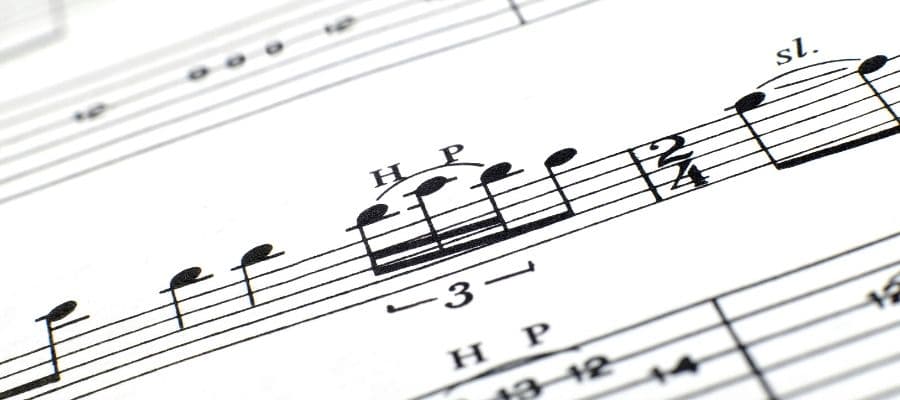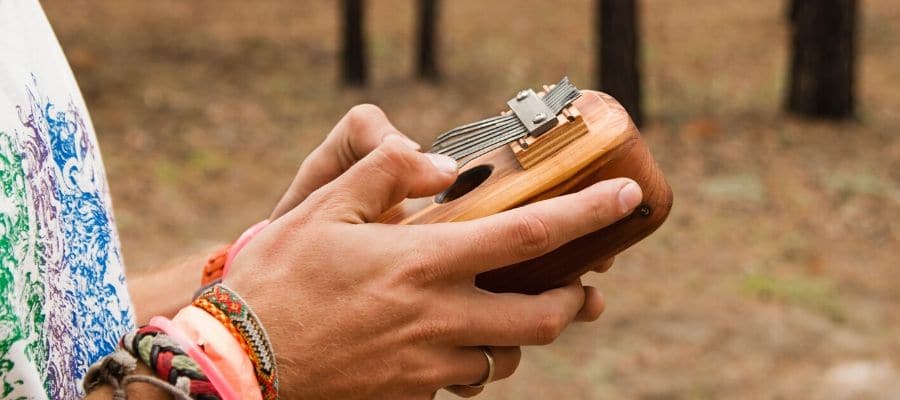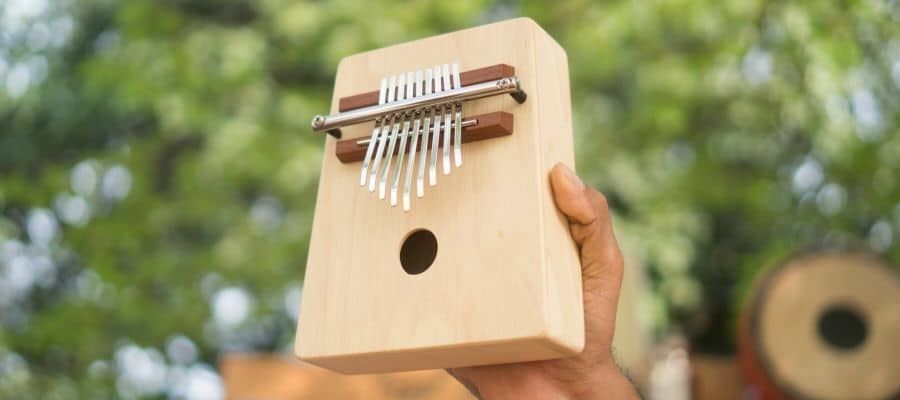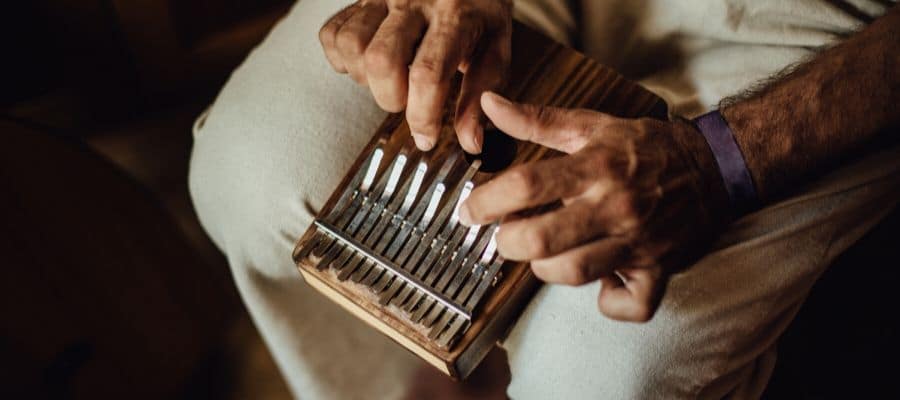Many people are wondering whether you can play sharps or flats on the kalimba. The main problem with kalimba is that it is commonly tuned to C major, which means that there are neither sharps nor flats.
So, is there some secret technique that will allow you to reach these notes on the kalimba? There is no way to play these notes on a regular kalimba without modifying the instrument. Tune the tines to the notes you want.
That being said, you can adapt the instrument to your needs, and find a way to get sharps and flats to be able to play a certain song. You can also adapt the song to your needs and play it in a different key to be able to play the notes you need.
Sharps And Flats On A Standard Kalimba In C Major

Assuming that you have a regular kalimba in the C major with seventeen keys, you will get a bit over two octaves. However, even with this many notes you still won’t get sharps or flats.
Instead of getting all the notes as you would have on the guitar or piano, you will have only notes from the C major scale. This means that there are seven different notes available and they are C, D, E, F, G, A, and B.
The next note after B would be a C, but one octave higher. To get a sharp or a flat from the note, you will need to play it half a step higher or lower, and on kalimba, this is not possible.
Similarly to the piano, you can’t really bend the notes or play it any other way around. But there is something you can do if you just need a few notes.
One way to go around this is to modify the song. If the song is in, let’s say, D major, the notes you’ll need are D, E, F#, G, A, B, and C#. As you can see there are two sharps which you won’t have on your C major kalimba.
But instead of trying to invent these notes, you can just play the song in C major. The progression of the scale is the same, and it goes like this full step, full step, half step, full step, full step, full step, half step.
Each major scale will follow this progression, which means that you can play any song as long as you change the key. The “distance” between E and F# in D major is the same as the one between D and E in C major.
Adding Extra Notes

The second way to go around this is to add the notes you’re missing. You can always take your tuning hammer, and change the note you need. For example, if you need F#, you can always change the F note half a step.
Unfortunately, this method will require you to lose a note to get one. And as you can imagine, it is not the best solution. You will also need to prepare yourself for a “missing” note to avoid plucking it by accident.
On the C major kalimba playing two adjacent notes will give you a chord, and if you re-tune one of these notes, playing the same chord will be impossible.
Plucking two or three notes at the same time is quite a popular technique for kalimba, and this way you will eliminate the chance to do this. Furthermore, you might get used to doing this and once you change a note, you will probably make a mistake by relying on muscle memory.
Change The Tuning

Now, you can always take everything a step further. Instead of changing one single note, you can change a bit more until you get a new tuning. Many people enjoy messing around different tunings and there are no limits to what you can try.
Even if you have a regular kalimba, you can get bored of the same seven notes, and all you have to do is experiment with it until you get something new and exciting.
This way, you will get a whole new instrument you can explore and have fun with. Naturally, you won’t have limitless possibilities, and the length of the tine will allow only a few changes.
Treble kalimba, or the one with seventeen tines, can easily be tuned to G major, but you can also try out B flat treble, D treble, or something more different.
Some people might suggest filing each tine and by doing so, you will change the key. While this method will work, the process is not reversible, and you won’t be able to change it back to the previous tuning.
I wouldn’t recommend filing the keys unless you have a couple of kalimbas and are prepared to potentially ruin one.
Getting A New Instrument

If you can afford it, you can always get a new kalimba tuned to a different key. Many players keep a couple of them around each tuned to a different key. This way, you will just pick the one you need for the song you want to play.
Needless to say, this method can be costly, and not many players are willing to do it, especially beginners.
Two main models you can find are alto and treble kalimbas. As I already mentioned, treble kalimba has fifteen keys. On the other hand, alto has only fifteen. The second instrument is a bit larger, and tines are wider.
Alto kalimba is usually in the key of G, and there are so many ways you can change it. While you can keep in the G major, you can also try A major, G minor, F major, or even some blues scales.
Ideally, you would have a couple of instruments of both types, and you would switch between them based on the song you want to play.
If you are looking to find more about different tunings, there are many articles online you can check out to find all the info you need.
Chromatic Kalimba

There are so many different types of thumb piano available, and the number of keys is just one of many variations you’ll encounter.
For more advanced players, chromatic kalimba might be a perfect choice. The main difference between this kalimba and other models is that it has two sets of tines.
The first one is on the front of the instrument, and here you will have a certain scale. Usually, it’s a G major. This means that you will get a single sharp or F# at your disposal. This will work the same way as a regular alto kalimba, and you’ll be able to use it the same way as any other thumb piano.
But on the back of the instrument there is a second set of tines. Here, you will get all the missing notes from the chromatic scale.
If you think about it, the front row will act as white keys on the piano, while all the black ones are behind.
Naturally, playing this instrument can be challenging, and you might need some time to adjust.
The main advantage is, of course, the possibility of playing any song since you will have all of the notes.
Essentially, by getting a chromatic kalimba, you will get two instruments and all the notes you’ll ever need.
If you are confused by two sets of tines, you can always check the link below to see how it looks.

Instead of only thumbs, you will need to use your index fingers as well since you will need to pluck the back tines as well.
Using Magnets

Everyone loves magnets, but did you know that you can use them on the kalimba? Using magnets will allow you to temporarily change the pitch of a single note without filing or re-tuning.
Here’s how it works. Firstly, you will need a small magnet. Ideally, it will be around four or five millimeters. Once you get it, just place it on the tine you want to change.
If you want to play a specific song, find the tine you won’t use or the one you want to change and place the magnet on it.
If you place it above the bridge, nothing will happen so this is a “safe” place to keep your magnets.
As I mentioned, you will need a small magnet that will stay on a single tine, and not cover the adjacent one.
Once you are ready to change the pitch of the tine, all you need to do is slide it down until you get the note you need. It’s as simple as that.
Needless to say, you will need to practice until you’re able to do it on the go, but if you have a tine you don’t need, you can use a tuner to adjust it to a different note.
It is a handy way to get a sharp or a flat without bothering with other methods.
Summary
For everyone playing the kalimba, having a single scale can be a problem, especially if you want to play along with a song.
People are wondering if there is a way to play sharps or flats which are otherwise unavailable on the C major kalimba.
While there isn’t a secret technique you can use to get semi-tones, there are other things you can try.
Firstly, you can always change the key or the scale on your kalimba using a tuner and a tuning hammer.
For those willing to invest a bit more, you can buy a new instrument that’s pre-tuned to a different key as well. Moreover, you can also find a chromatic kalimba that will allow you to play every possible note.
Finally, the easiest way to temporarily change the pitch of a single note is by using a magnet. Just place it on the tine, and slide it down until you get the note you need.
If you found this article useful you may want to save this pin below to your Kalimba board



hey jacob,
Awesome article.
Can’t thank you enough.
I am noob to musical instrument so i had a question.
Do you mean if i play notes according to the distance instead of the notes itself it would sound the same?